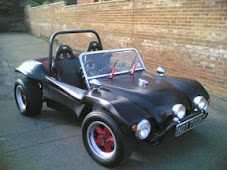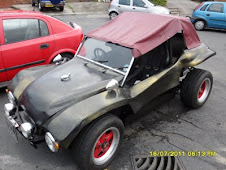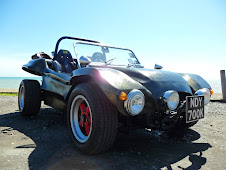 25th July 2008
25th July 2008Readers of this blog are aware that I had a catastrophe that was caused by a small piece of bakerlite that sat under the fuel pump. Whilst servicing a crack in this item I managed to shear of the Bakelite and drop a small piece of it into the crankcase. This was disastrous as my engine had done less
 than 250 miles since its last rebuild and there was no way of retrieving it other than dismantling the engine. Firstly I must say a thanks to the informed members of VZI who stated not only where the parts would end up but where they would get mashed and what they would destroy if left in situe. To be quite frank they stated the exact position. The yellow arrow points to where the bits ended up. This is just under the timing gear on the camshaft. The green arrow shows the oil feed to the crankshaft. The red arrow shows the lower pump ring that the Bakelite pump bush fits into.
than 250 miles since its last rebuild and there was no way of retrieving it other than dismantling the engine. Firstly I must say a thanks to the informed members of VZI who stated not only where the parts would end up but where they would get mashed and what they would destroy if left in situe. To be quite frank they stated the exact position. The yellow arrow points to where the bits ended up. This is just under the timing gear on the camshaft. The green arrow shows the oil feed to the crankshaft. The red arrow shows the lower pump ring that the Bakelite pump bush fits into.To be honest I am glad VZI exists. First drain the engine oil.
I stripped the engine down in a day removing the cylinder heads by removing the rocker covers , then the rocker shafts and then the eight nuts that hold each of the heads in place. With the heads
 removed the barrels could be removed taking special care to get them out so far that the gudgeon pins could be removed and the pistons removed still attached to the barrels. This is a little tricky but with a pair of long nose pliers to remove the circlips the pistons can be removed by sliding out the gudgeon pins. These can sometimes be a little st
removed the barrels could be removed taking special care to get them out so far that the gudgeon pins could be removed and the pistons removed still attached to the barrels. This is a little tricky but with a pair of long nose pliers to remove the circlips the pistons can be removed by sliding out the gudgeon pins. These can sometimes be a little st iff and a warm air blower like a paint stripper is enough to gently warm the piston to make the pin slide out again. With the pistons and barrels removed the main pulley can be undone at the front of the engine. If this is tight then the flywheel will need to be locked in position. Personally I tried to use a bar between two bolts and still resorted to buying the correct tool from eBay. This fits into the top engine bolt and securely holds the flywheel so that the front pulley and then flywheel nut can be undone. The short block is then able to be split. I removed the cylinder studs and the oil pump and the oil strainer first to allow better access to the case. There are eight large 17mm bolts and a large number of 13mm bolts around the case that all need to be undone. Make sure that you have got to all the 13mm bolts as there are some that are hidden tight against the back of the fly wheel and also in other hard to get to areas. With all the engine nuts undone . The case will still be stuck together. You will need a rubber mallet or a piece of wood and a hammer to carefully knock the case apart generally speaking its easier to lay the engine on a block of wood on its left hand side so the eight large studs are facing you. There are several good places around the case that you can hit , which will break the case seal. Once you have the case halves separated you can draw the top half on the engine case of the bottom. This will expose all of the internal workings of the engine so make sure you have a large quantity of rags or cloths that you can mop up the oil slick that comes out. Before going further you need to retrieve the cam followers that have fallen into the bottom case. You also need to check that you have two dots on the crankshaft camshaft timing gear and one on the camshaft gear. these are vital to lining up the engine timing, when the hole engine is put back together. Once this has been determined remove the camshaft and cam bearings and place them in a box. Carefully lift out the crankshaft with the con rods and put this in another box with some rags to soak up the oil. You need to ensure that you have all of the bearing halves out of the engine.
iff and a warm air blower like a paint stripper is enough to gently warm the piston to make the pin slide out again. With the pistons and barrels removed the main pulley can be undone at the front of the engine. If this is tight then the flywheel will need to be locked in position. Personally I tried to use a bar between two bolts and still resorted to buying the correct tool from eBay. This fits into the top engine bolt and securely holds the flywheel so that the front pulley and then flywheel nut can be undone. The short block is then able to be split. I removed the cylinder studs and the oil pump and the oil strainer first to allow better access to the case. There are eight large 17mm bolts and a large number of 13mm bolts around the case that all need to be undone. Make sure that you have got to all the 13mm bolts as there are some that are hidden tight against the back of the fly wheel and also in other hard to get to areas. With all the engine nuts undone . The case will still be stuck together. You will need a rubber mallet or a piece of wood and a hammer to carefully knock the case apart generally speaking its easier to lay the engine on a block of wood on its left hand side so the eight large studs are facing you. There are several good places around the case that you can hit , which will break the case seal. Once you have the case halves separated you can draw the top half on the engine case of the bottom. This will expose all of the internal workings of the engine so make sure you have a large quantity of rags or cloths that you can mop up the oil slick that comes out. Before going further you need to retrieve the cam followers that have fallen into the bottom case. You also need to check that you have two dots on the crankshaft camshaft timing gear and one on the camshaft gear. these are vital to lining up the engine timing, when the hole engine is put back together. Once this has been determined remove the camshaft and cam bearings and place them in a box. Carefully lift out the crankshaft with the con rods and put this in another box with some rags to soak up the oil. You need to ensure that you have all of the bearing halves out of the engine.With the cases bare you can start to mop out the engine oil. It is generally better to get your case professionally cleaned if you can locate someone who will do it for you.
I have purchased a new Bugpac camshaft and a barrel and piston Marle forged set-up that will bring the engine CC to 1914cc when they are fitted. I will need to acquire a new set of heads before I can have the case altered to fit them. These are very expensive and I will have to work out which ones re the best to use for their respective cost.
 Next I will remove the oil plugs and re-thread them to allow fo
Next I will remove the oil plugs and re-thread them to allow fo r any eventuality that the engine needs in the future. I ordered the brass screw caps 3 x 3/8 NPT , 2 x 1/4NPT , 5 x 1/8th online from http://www.airlink-compressors.co.uk/Fittings/plugs.htm, unfortunatly thier website ordering was down and I had to telephone the order through. In the mean time I had to find a 9/16 drill bit and a 1/32 or American R size drill. I choose the 11/32 as I already had one. The next challange was to locate the taps. My tap set came with a 1/8NPT trap but finding a 1/4NPT or never mind a 3/8" NPT tap was going to be a challange. I posted a wanted advert on VZI to see if anyone had any.
r any eventuality that the engine needs in the future. I ordered the brass screw caps 3 x 3/8 NPT , 2 x 1/4NPT , 5 x 1/8th online from http://www.airlink-compressors.co.uk/Fittings/plugs.htm, unfortunatly thier website ordering was down and I had to telephone the order through. In the mean time I had to find a 9/16 drill bit and a 1/32 or American R size drill. I choose the 11/32 as I already had one. The next challange was to locate the taps. My tap set came with a 1/8NPT trap but finding a 1/4NPT or never mind a 3/8" NPT tap was going to be a challange. I posted a wanted advert on VZI to see if anyone had any.I started cutting the threads for the 1/8NPT this seemed fairly straight forward. I had to shorten the tap I was using to allow me to get the thread further into the crank case. I fitted the brass plugs into the threads as I went. I then retrurned to them to remove them finding one had stuck tight. Foolishly I tried to remove the plug after the allen key slot rounded in the plug. I used a screw puller and to my horror cracked the crankcase around the gantry
Was this the end for the crankcase would I need to buy a new engine?






















No comments:
Post a Comment